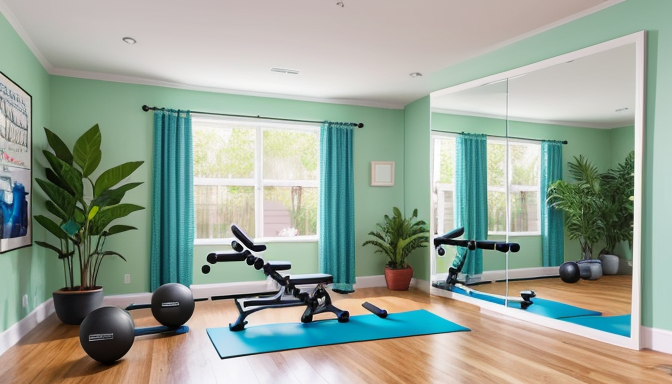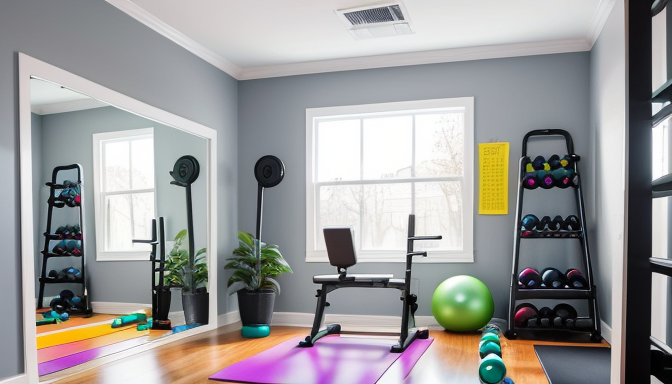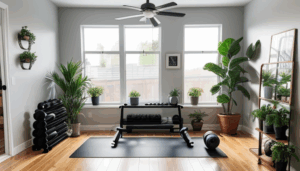Starting a home gym can feel like a daunting task, but it doesn’t have to be! Imagine transforming a small corner of your living room or basement into a personal fitness sanctuary. The best part? You don’t need a fortune or a massive space to make it happen. Let’s dive into some practical steps and tips that will help you create a home gym that fits your lifestyle and budget.
First off, think about your available space. Whether it’s a spare room, garage, or even just a section of your living area, every bit counts! Take a moment to assess your surroundings and visualize how you can maximize functionality. Consider factors like lighting, ventilation, and even the flooring. A comfortable environment can make all the difference in your workout experience.
Next, let’s talk about equipment. It might be tempting to splurge on all the latest gadgets, but you can start with just a few essential pieces that cater to your fitness level. Think about items like dumbbells, resistance bands, or a yoga mat. These can provide a variety of workout options without breaking the bank. Remember, quality over quantity is key!
Once you have your space and equipment sorted, it’s time to create a workout plan. This is where the magic happens! Design a routine that fits your schedule, includes a mix of cardio and strength training, and allows for progression. Keeping it fresh and exciting will help you stay committed. After all, who wants to do the same boring workout day in and day out?
Lastly, staying motivated is crucial for your home gym success. Set achievable goals, track your progress, and don’t shy away from mixing things up. Think of your home gym as a canvas—the more creative you are, the more fun it will be! So, grab your gear, put on your favorite playlist, and let’s get moving!
Assessing Your Space
Understanding the available space in your home is crucial when you’re aiming to create the ultimate home gym. Imagine transforming a corner of your living room or a spare bedroom into your personal fitness sanctuary! First things first, take a good look around. Is there a room that feels underutilized? Maybe a basement or a garage? These areas can be perfect for setting up your gym. The key is to maximize functionality while ensuring you feel comfortable and motivated to work out.
When assessing your space, consider the following factors:
- Size: Measure the dimensions of your chosen area. You don’t need a huge space; even a small area can work wonders if arranged well.
- Flooring: Think about the type of flooring. Hardwood, carpet, or concrete can influence your workouts. You might need mats for comfort and safety.
- Lighting: Natural light can boost your mood. If possible, choose a space with windows or add some bright lighting to keep the energy up.
- Ventilation: A well-ventilated area is important. Make sure you can open windows or have a fan to keep the air fresh while you sweat it out.
Once you’ve evaluated these aspects, it’s time to visualize your gym layout. Think about where you want to place your equipment for easy access and flow. You could even sketch a simple floor plan! Remember, your home gym should feel inviting and energizing. So, don’t hesitate to add personal touches like motivational posters or your favorite colors to make the space truly yours.
In conclusion, assessing your space is not just about finding a spot to put your weights; it’s about creating an environment that inspires you to reach your fitness goals. So grab a tape measure, get creative, and start planning your dream workout space!

Choosing the Right Equipment
When it comes to setting up your home gym, is absolutely crucial. Imagine trying to cook a gourmet meal with just a single frying pan; it’s possible, but it’s not going to be a delightful experience. Similarly, having the right tools can make your workouts not just effective but also enjoyable. So, what should you consider when selecting your gear?
First off, think about your fitness goals. Are you looking to build strength, improve your cardio, or maybe a bit of both? This will help you narrow down your choices. For example, if strength training is your focus, investing in a set of dumbbells or a could be a game-changer. On the other hand, if cardio is your jam, a stationary bike or jump rope might be more your speed.
Next, consider your available space. You don’t want to buy a massive treadmill if you live in a cozy apartment. Instead, look for space-saving options like foldable benches or resistance bands that can be easily stored away. Here’s a quick comparison of some essential equipment:
| Equipment | Purpose | Space Requirement |
|---|---|---|
| Dumbbells | Strength Training | Minimal |
| Resistance Bands | Full Body Workout | Minimal |
| Stationary Bike | Cardio | Moderate |
| Treadmill | Cardio | High |
Lastly, don’t forget about your budget! You don’t need to break the bank to create a functional gym. Look for second-hand equipment or check out local marketplaces. Remember, it’s not about how much you spend but how effectively you use what you have. With the right mindset and equipment, your home gym can be a sanctuary for fitness and well-being!
Creating a Workout Plan
So, you’ve set up your home gym, and now it’s time to dive into the exciting world of fitness! But wait—before you jump headfirst into a whirlwind of workouts, let’s talk about the importance of a solid workout plan. Think of your workout plan as your roadmap; without it, you might just wander around aimlessly, hoping to stumble upon your fitness goals.
First things first, you need to determine how many days a week you can realistically commit to exercising. Are you a busy bee or do you have some flexibility in your schedule? A good starting point is to aim for at least three to five workouts per week. This frequency allows your body to adapt while also giving you enough time to recover. Remember, recovery is just as important as the workout itself!
Next, let’s talk about the types of exercises you want to include. A well-rounded workout plan should incorporate a mix of cardio, strength training, and flexibility exercises. This not only keeps things interesting but also ensures you’re hitting all the major muscle groups. Here’s a quick breakdown:
- Cardio: Think running, cycling, or even dancing! Aim for at least 150 minutes of moderate aerobic activity each week.
- Strength Training: Incorporate weights or resistance bands to build muscle. Aim for at least two days a week.
- Flexibility: Don’t forget to stretch! Yoga or simple stretching routines can enhance your flexibility and prevent injuries.
Finally, keep your plan dynamic. As you progress, don’t hesitate to switch things up! Challenge yourself with new exercises, increase weights, or try different workout styles to keep the excitement alive. Remember, the goal is to stay motivated and enjoy the journey. You’ve got this!

Staying Motivated
Staying motivated in your home gym can sometimes feel like trying to lift a heavy weight without any support. But fear not! With the right strategies, you can keep your energy levels high and your enthusiasm even higher. First off, it’s essential to set clear goals. Whether you want to lose weight, build muscle, or just feel healthier, having specific targets gives you something to strive for. Think of it like having a roadmap; without it, you might just wander aimlessly.
Another effective way to maintain your motivation is by tracking your progress. You could use a simple notebook or a fitness app to jot down your achievements. Seeing how far you’ve come can be a huge boost! Consider creating a progress chart where you can visually track your workouts and milestones. This not only keeps you accountable but also adds a fun element to your routine.
| Motivation Strategies | Benefits |
|---|---|
| Set Clear Goals | Provides direction and purpose |
| Track Progress | Visual representation of achievements |
| Incorporate Variety | Prevents boredom and keeps workouts fresh |
| Workout with a Friend | Boosts accountability and makes it fun |
Finally, don’t underestimate the power of variety. Mixing up your workouts not only keeps things exciting but also challenges your body in new ways. Try different exercises, change your routine every few weeks, or even explore new fitness trends. And if you can, invite a friend to join you! Working out together can turn a mundane session into a fun social event, making it easier to stick to your routine.
In conclusion, staying motivated in your home gym is all about finding what works for you. Embrace the journey, celebrate your victories, and remember, the only bad workout is the one you didn’t do!
Budgeting for Your Home Gym
When it comes to building your dream home gym, budgeting is a critical step that can set the tone for your entire fitness journey. It’s easy to get carried away with flashy equipment and trendy gadgets, but the key is to focus on what truly matters. Start by determining your overall budget—this will help you prioritize your purchases and avoid overspending. Think of your budget as a roadmap; it will guide you through the maze of options available in the market.
Next, consider what equipment you’ll need to achieve your fitness goals. Essential items like dumbbells, resistance bands, and a yoga mat can be quite affordable and versatile. In contrast, more specialized equipment, such as a treadmill or a weight bench, can be costly. Here’s a quick comparison of essential vs. optional equipment to help you decide:
| Essential Equipment | Optional Equipment |
|---|---|
| Dumbbells | Smith Machine |
| Resistance Bands | Rowing Machine |
| Yoga Mat | Stationary Bike |
Once you’ve identified your must-haves, it’s time to get creative with your spending. Check out local marketplaces, online sales, or second-hand stores to find quality equipment at a fraction of the price. You’d be surprised at the gems you can find! Also, don’t forget to factor in additional costs, such as flooring, mirrors, and storage solutions, which can enhance your workout experience.
In conclusion, budgeting for your home gym doesn’t have to be a daunting task. With a clear plan and some savvy shopping, you can create a space that not only fits your financial constraints but also inspires you to reach your fitness goals. So, are you ready to get started?
Frequently Asked Questions
- What equipment do I really need to start a home gym?
To kick off your home gym journey, you don’t need to break the bank! Start with the basics: a set of dumbbells, a yoga mat, and resistance bands. These essentials can provide a solid foundation for a variety of workouts, helping you build strength and flexibility without overwhelming your space or budget.
- How do I stay motivated to work out at home?
Staying motivated at home can be tricky, but it’s all about creating a fun environment! Set clear goals, track your progress, and mix up your routines. Think of it like a playlist: keep adding new “tracks” to keep your workouts fresh and exciting! You can even invite friends to join virtually to make it a social event.
- How can I budget for my home gym?
Budgeting for your home gym can be simple! Start by determining how much you can comfortably spend. Prioritize essential items first, and look for sales or second-hand options to save money. Remember, a great workout doesn’t require fancy equipment; it’s all about how you use what you have!
- What’s the best way to create a workout plan?
Creating a workout plan is like drawing a map for your fitness journey! Start by deciding how many days a week you want to work out. Include a mix of strength training, cardio, and flexibility exercises to keep things balanced. Just like cooking, don’t be afraid to adjust the recipe until it’s perfect for you!

